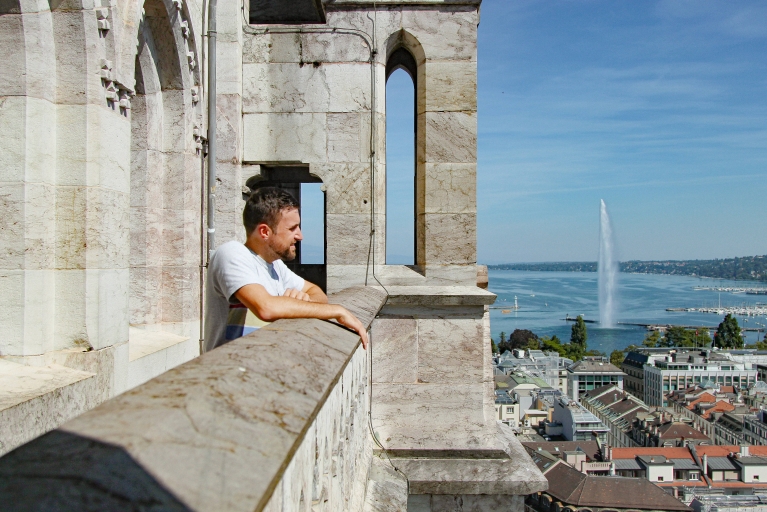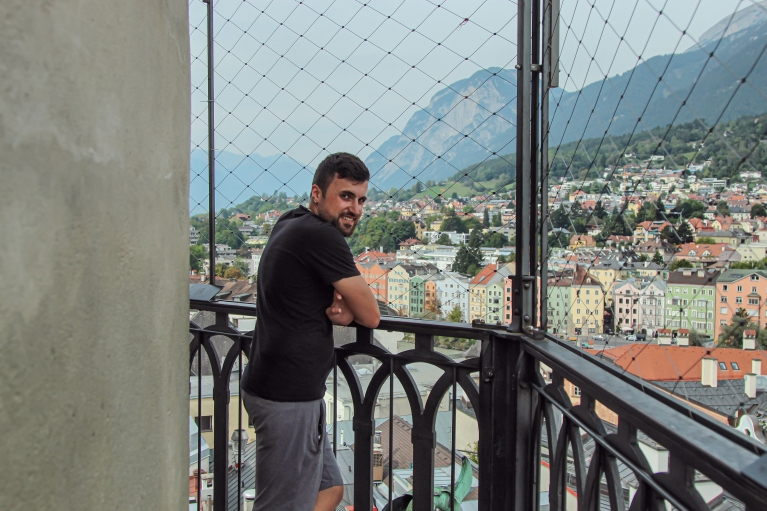Travelling with autism: My tips for using the Interrail Pass
19 January 2024
I’m Alex Stratikis, founder of Autism Adventures Abroad, an inclusive platform with the aim of inspiring young autistic people to travel. I also work with the travel and tourism industry to review and improve their accessibility offerings to attract autistic travellers – a huge untapped customer base. I do this through a variety of means: my social media platforms, writing blogs, guides, and magazine articles, giving interviews for podcasts and radio programs, paid consultancy work, and participating in a range of events such as conferences, seminars, and social media live events.
Having visited a wide range of far-flung places, including Hawaii, Malaysia, Egypt, Jordan, and the United Arab Emirates, I usually travel by plane. So, when I got the opportunity to travel across Europe by train for Interrail using their Global Pass — with the aim of writing about my experience as an autistic traveller — I could not resist!
Along the way, I discovered the benefits and challenges of travelling with the Interrail Pass. Curious about trying an Interrail journey of your own? Here is how I approached my trip and a few tips to keep in mind as you plan your Interrail adventure.

Planning my Interrail trip
Europe is the world’s best-connected continent, with open borders across much of the region. Thanks to the Schengen system, cross-country connections are often quick and easy, as well as more frequent than in many other places around the world.
The Interrail Pass covers over 30,000 destinations in 33 countries, including multiple participating ferry routes in the Mediterranean. The choice of locations can be overwhelming. Especially if, like me, you want to travel everywhere!
Fortunately, travellers can often change any part of their planned Interrail route at any time, a perk I took advantage of while crossing Germany — more on that below.
I began the planning process by jotting down several possible routes to follow over the course of my month-long adventure. Then, I considered how long I wanted to stay in each destination and projected budgets for each location. After some difficult cuts and a few tweaks, I finally decided on an ambitious journey to nine countries in 30 days. The most exciting part of my draft itinerary? It would be my first time visiting each destination, resulting in a month of brand-new adventures.
Before beginning my journey, I booked seats on my first three trains: Edinburgh to London, London to Paris, and Paris to Geneva. While I had a planned route in mind, I chose to book my seat reservations on a staggered basis, as I knew I might change my mind at some point. This was the right call; on my way to Scandinavia from Austria, I made a spur-of-the-moment decision to break up my journey through Germany, visiting Stuttgart on the way to Sweden and Hamburg on the way back. I did not want to spend all day travelling, which in turn allowed me to see a few extra locations on brief stopovers.
I recommend making full use of the flexibility the Pass offers, since it’s not often that travellers get to chance to change their itinerary last-minute without a hefty price tag.
One important note for planning your trip: travellers with disabilities who need assistance can request a complimentary Pass for an accompanying caregiver. To apply, simply visit Interrail’s Help Centre to get in touch.
Navigating Interrail’s website
While planning my journey, I found that the Interrail website contained lots of useful information. The information I required was split across several different pages, so I checked each page thoroughly. Should customers be unable to find the information they are looking for, they can contact Interrail under the Help Centre on the site.
In terms of overall navigation, the website is simple, with a lot of images on each page. This could be a detractor for some, but I found it to be a helpful design choice. Information about the Pass is compartmentalised into different subheadings across four main drop-down menu options. Some might feel overwhelmed by the number of pages on the site (or have difficulty associating a particular heading with the information they are looking for), and I recommend travellers make sure to read all headings thoroughly to find the information they need.
1st vs. 2nd Class Travel
I travelled with a 1st class Interrail Pass, which I recommend for anyone who appreciates or needs space and comfort while on the train.
The 1st class carriages were quiet on most of my journeys, an advantage for someone who, like me, often associates the travel experience with overstimulation (though I found Germany’s 1st class carriages to be a noticeable exception). In every case, the 1st class coaches were just as busy as the 2nd class coaches.
Some rail companies offer additional benefits for 1st class travel. For example, my initial journey in the United Kingdom with London North Eastern Railway offered 1st class passengers complimentary food (sandwiches, pastries, cakes, etc.) and hot and cold beverages (including alcohol). The journey from Edinburgh to London was long, but I was well catered to throughout the journey. I was equally well catered to onboard the Eurostar. with a full meal, including a starter, main course, and dessert with hot and cold beverages served in the 1st class carriage.
I also made use of the 1st class lounge access in various locations, including Austria, Sweden and the United Kingdom. I really appreciated having a quiet space, away from the crowds, with access to plenty of drinks and snacks to replenish my energy between journeys.

Accessibility while travelling
Having access to a Pass took away the stress of having to plan and book each journey individually. It is not on the same level as being in a tour group, since you still must plan your own route and book seat reservations, in some cases. However, I loved having all train journeys available in one itinerary that can be altered with the click of a button at any time. I felt spoiled being able to modify my journey hassle-free.
Airports and the overall flying experience are a major hurdle for many autistic people, including myself, when going on vacation. Many travellers now expect and accept the stress and inconvenience that goes along with flying.
The stresses of air travel – such as immigration and security procedures - can still exist while travelling by train, depending on your route. However, the environment is usually calmer and more relaxed, helping me to feel more at ease than I do at airports. It is worth noting that I did not need to go through immigration or security at any point of my trip, aside from when I left the United Kingdom.
Sensory rooms and quiet rooms exist within some stations in the United Kingdom, but, in my experience, they don’t seem to be widely available within railway stations in Europe at large. It is therefore wise to check the accessibility statements of individual stations online to see what they have available.
I made sure to bring my sunflower lanyard on my trip. For those who are not aware of the program, the Hidden Disabilities Sunflower lanyard allows people to discreetly share that they have a disability or condition and may need additional support. In my experience, recognition of this scheme is on a station-by-station basis and likely to improve over time, with new businesses, organizations and institutions adopting the scheme. In the United Kingdom, all train operators have recognised the lanyards since 2020.
The last word
Overall, travelling with an Interrail Pass was an amazing experience, which I would highly recommend to anyone who loves to travel. Just sit back and enjoy the experience!
Feeling inspired? With Interrail and Eurail, you can:
Change of currency
You cannot change the currency once you have a Pass in your cart. Remove the Pass, and then change the currency on the website header.







